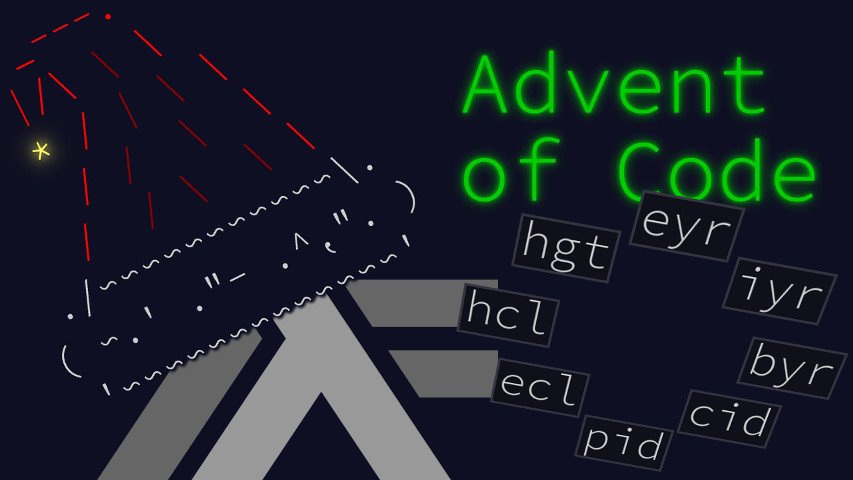A straightforward implementation will do the trick for today’s puzzle. This post is literate Haskell, starting with a few imports and extensions.
{-# LANGUAGE LambdaCase #-}
{-# LANGUAGE ViewPatterns #-}
import Data.Bifunctor
import Data.Char
import Data.List.SplitA passport is a set of key/value pairs. I’ll store it in an association list.
type Passport = [Field]
type Field = (FieldId,Value)
type FieldId = String
type Value = StringTo parse, I’ll split paragraphs, then split by words and break on colon.
parsePassport :: String -> Passport
parsePassport = map parseField . words
parseField :: String -> Field
parseField = second tail . break (== ':') In part 1, “valid” means “containing all the required fields”.
validate1 :: Passport -> Bool
validate1 passport = all (`elem` map fst passport) fieldIdsIn part 2, “valid” means “present and abiding by some field-specific rules”. I’ll define a type for a function that validates a field value.
type Validator = Value -> BoolThree fields are validated by a numerical interval check.
digits :: Int -> Int -> Int -> Validator
digits len low high ds =
length ds == len
&& read ds >= low
&& read ds <= highMy input is very nice to me: it’s well-formed enough that this
read call never fails.
Now I can define an alist of validators.
validators :: [(FieldId,Validator)]
validators =
[ ("byr",digits 4 1920 2002)
, ("iyr",digits 4 2010 2020)
, ("eyr",digits 4 2020 2030)The “eye color” field is a simple membership check from a hardcoded set; I can define it inline.
, ("ecl",(`elem` ["amb","blu","brn","gry","grn","hzl","oth"]))The “passport id” field has two conditions, but a lambda expression fits the bill.1
, ("pid",\ds -> length ds == 9 && all isDigit ds)The last two fields are a bit too complex to fit in a line. I’ll defer to toplevel functions.
, ("hgt",height)
, ("hcl",hairColor)
]Height is a “digits” field with a unit, with differing allowed ranges depending on the unit.
height :: Validator
height (break isLetter -> (ds,unit)) =
case unit of
"cm" -> digits 3 150 193 ds
"in" -> digits 2 59 76 ds
_ -> FalseHair color is a 6-digit HTML color code. I’ll check for syntax and length by pattern-matching.
hairColor :: Validator
hairColor = \case
'#':xs@[_,_,_,_,_,_] -> all isHexDigit xs
_ -> FalseNow I can wrap it all to check an entire passport.
validate2 :: Passport -> Bool
validate2 passport =
all (\(f,v) -> maybe False v (lookup f passport)) validatorsSince the field list is the same, I can avoid repeating myself and derive it from the validators’ alist.
fieldIds :: [FieldId]
fieldIds = fst <$> validatorsObviously, the country id field is a red herring: since it’s valid to have it as well as not have it, and its contents are ignored, it doesn’t ever need to be checked or even appear in my code.
main :: IO ()
main = do
ps <- map parsePassport . splitOn "\n\n" <$> readFile "day04.in"
print $ length $ filter validate1 ps
print $ length $ filter validate2 psThis concludes today’s solution. See you soon!
If you follow me through Twitter, you may have noticed I had a little trouble feeling excited about this one. If you want a more interesting way to do it, I recommend reading up Justin Le’s refinement types approach.
Yes, I know how to do without by lifting
(&&)in the reader applicative. This is educational code.↩︎



